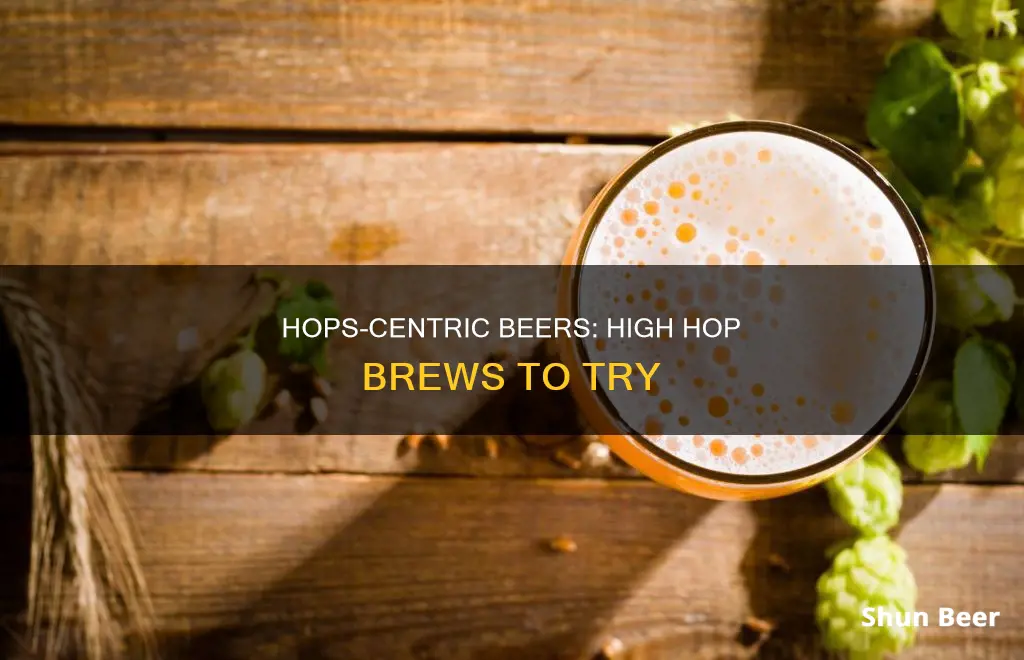
Hops are one of the four essential ingredients in beer, alongside barley, yeast, and water. They are the cone-shaped flowers of the female hops plant, aka Humulus lupulus, and are responsible for adding bitterness, flavour, and stability to the finished beer. While all beers contain hops, some are more hoppy than others. The hoppiest beer style is the IPA, or India Pale Ale, which has become the mascot of craft beer. However, the rise of the New England IPA has led to beers with less bitterness, as brewers are using brewing methods that prevent hops from adding bitterness. If you're looking for a beer that's high in hops, try a West Coast IPA or an East Coast IPA to taste the differences in flavour and regional characteristics.
| Characteristics | Values |
|---|---|
| Beers with high hops | India Pale Ale (IPA), West Coast IPA, East Coast IPA, New England IPA, Anchor Steam, Prima Pils, Dunkel, Saison, Doppelbock, Amber Ale |
| What hops do to beer | Hops balance the sweetness of the malt and add bitterness, flavour, aroma, and stability to the beer. |
| How hops are added to beer | Hops are added to the boil stage of brewing. They can also be dry hopped (added to the fermenter) or fresh hopped (when just-picked hops are brought straight to the brewery). |
| How to know how hops have been used in a beer | Check the IBU level (International Bittering Units) of the beer. |
What You'll Learn

Hops are one of four essential beer ingredients
Hops are indeed one of the four essential ingredients in beer, alongside water, yeast, and barley or malted barley. However, this wasn't always the case. In the Middle Ages, brewers flavoured their beer with a mixture of herbs and spices called "gruit", and it wasn't until the 15th century that hops began to be used as the fourth ingredient in beer.
Hops are the flowers, or cones, of the female hop plant, Humulus lupulus, a member of the Cannabaceae family of flowering plants, which also includes cannabis. Hops contain acids and oils that impart bitterness, flavour, and stability to the finished beer. They also act as a preservative, extending the life of the beer.
Hops are typically added to the boil stage of brewing, as it takes around an hour to unleash the "alpha" acids that bitter and balance the sweetness of the malt. However, they can also be added later in the process to impart more aroma than bitterness, or even used fresh, without drying. The choice and timing of hops will depend on the style of beer being brewed and the desired flavour profile.
While all beers contain hops, they don't always have a starring role. In many cases, hops play a supporting role, providing structural support while other flavours are emphasised. However, in recent years, hops have moved from a supporting to a starring role, with the rise of heavily hopped beers like IPAs (India Pale Ales). These beers showcase the hop flavour and aroma and have led to a trend towards bitter, hoppy styles.
Dry Hopping Mr. Beer: A Step-by-Step Guide to Success
You may want to see also

Hops balance the sweetness of beer
Hops are essential to balancing the sweetness of beer. They are one of the four essential ingredients in beer, along with barley, yeast, and water. Hops contain acids and oils that impart bitterness, flavour, and stability to the finished beer. The alpha acids in hops dissolve in the wort during brewing, adding bitterness to the beer and balancing the sweetness of the malt. This balance between bitterness and sweetness is what most people seek in a quality beer.
Hops are the cone-shaped flowers of the female hops plant, Humulus lupulus, a cousin of the cannabis plant. They are added during the boil stage of brewing to unleash the alpha acids that provide bitterness. The timing of hop addition can vary depending on the desired flavour profile. Adding hops earlier in the boil creates a more bitter beer, while adding them later results in a more delicate hop aroma.
Different types of hops have unique characteristics and can be used to create a variety of flavours and aromas in beer. For example, Cascade hops are known for their floral and citrusy flavour, while Simcoe hops impart piney, citrusy, and earthy flavours.
In addition to bitterness, hops also contribute to the overall flavour profile of the beer, adding hints of citrus, pine, or floral notes. They also act as a preservative, extending the shelf life of the beer. This preservative quality was especially important in the past, such as in traditional India pale ales, where heavy hop rates helped preserve the beer during long journeys.
While hops are often associated with bitterness, they can also be used to provide aroma and flavour without adding significant bitterness. This is achieved by adding the hops later in the brewing process or using techniques like dry hopping, where hops are added directly to the fermented beer.
The role of hops in beer is not just limited to providing bitterness and flavour. They also help maintain a beer's foamy head and lend antibacterial qualities. The right yeast strain can also enhance the hop flavour and aroma. For example, an English yeast strain may produce fruity esters that complement the citrusy flavour of American hops.
Finding the right balance between sweetness and bitterness is crucial in creating a great-tasting beer. The International Bitterness Units (IBU) scale measures the concentration of iso-alpha acids in beer, which are produced by the hops during brewing. A higher concentration of iso-alpha acids results in a higher IBU and increased bitterness. However, it's important to note that the perception of bitterness is subjective and can be influenced by factors such as malt sweetness, alcohol content, and hop aroma.
Hops in Beer: What Else Contains This Ingredient?
You may want to see also

Hops are added at different stages of the brewing process
Bittering hops are added once the wort has been collected in the kettle and a rolling boil has been achieved. They are usually boiled for 60 minutes, although some recipes call for as little as 30 minutes. Without the bitterness from the hops, the beer would taste overly sweet. Hops also act as a natural preservative, extending the life of the beer.
Flavouring hops are generally added with between 15 and 30 minutes remaining in the boil. In this timeframe, very little bitterness will be extracted from the hops, but a crisp hoppy flavour will be imparted.
Aroma hops are typically added during the last 5 minutes of the boil or at flame out, when the kettle is removed from the heat. The hop oils that contribute to aroma are extremely volatile and will be driven off in the steam of the boil almost immediately, so it is important not to boil aroma hops for long.
In addition to these three stages, hops can also be added during the mash, although the bittering and flavour impacts will be modest. Hops can also be added post-boil, either at flame-out, during whirlpooling, or using a hopback.
Finally, hops can be added post-chill, in a process known as dry hopping. Dry hopping adds hop oils and can impart flavour and aroma without adding measurable IBUs, as there is no heat involved.
Hops: Brewing Demand and Future Growth
You may want to see also

Hops are associated with bitterness
Hops contain organic compounds called alpha and beta acids, which account for the bitter flavour in beer. Most of the bitterness comes from alpha acids, of which there are many, but five main compounds: humulone, cohumulone, adhumulone, posthumulone, and prehumulone. During the brewing process, they are degraded to form iso-alpha acids, which are more soluble and contribute much of the bitterness associated with beer. The main alpha acid present in the majority of hops is humulone, although hops with varying compositions may be selected to vary the type and level of bitterness in the beer.
Beta acids are another class of compounds found in hops and transferred to beer during the brewing process. There are three main types of beta acids: lupulone, colupulone, and adlupulone. They impart a harsher bitterness than alpha acids, but as they are insoluble, their contribution to the overall flavour is much lower. They do not isomerise in the same way as alpha acids during fermentation but instead slowly oxidise to produce their bitter flavour. Because they take much longer to do this, their effects become more potent the longer the beer is fermented and aged.
While alpha and beta acids provide the bitterness of the beer, essential oils from the hops are responsible for the bulk of the aroma and flavour. Some of these oils are very volatile, evaporating easily, so they are usually obtained by adding hops later in the brewing process or by using the "dry hopping" technique, which involves soaking hops in the finished beer for several days or weeks. Over 250 essential oils have been identified in hops, with myrcene, humulene, and caryophyllene being the main oils found in the highest concentrations. Humulene, in particular, is responsible for the characteristic hoppy aroma of beer.
Hops have been associated with brewing since the 8th century when they were first used in the Hallertau region of Germany. Beers brewed with hops must have tasted far better than other beers of the period, as the use of hops spread throughout the beer-brewing regions of Europe, and by the 1600s they were in widespread use. Today, hops are mainly used to provide bitterness and aroma in beer.
Hop Boiling in Beer: Necessary or Not?
You may want to see also

Beers with high IBU are high in hops
Hops are one of the four essential ingredients in beer, alongside barley, yeast, and water. They are the cone-shaped flowers of the female hops plant, Humulus lupulus, and are added to the boil stage of brewing to impart bitterness, flavour, and stability to the finished beer. While hops are most often associated with bitterness, they can also add aroma, flavour, and act as a preservative.
The role of hops in beer has evolved over time. In the Middle Ages, brewers flavoured their beer with a mixture of herbs and spices called "gruit", but by the 15th century, hops had become the dominant ingredient for adding bitterness and flavour. Today, hops are often used to showcase their unique characteristics, with different varieties offering flavours that can be fruity, earthy, citric, floral, or piney.
When it comes to measuring the bitterness of a beer, brewers use International Bitterness Units (IBUs). This scale quantifies the concentration of isohumulone, an acid derived from hops, in the beer. A beer with over 80 IBUs is generally considered to be on the higher end of the bitterness scale. However, it's important to note that the perceived bitterness of a beer also depends on other factors such as the malt content and ABV.
Beers with high IBU values are typically those that feature hops as a prominent ingredient. These beers showcase the unique flavours and aromas that hops can impart. While IPAs are often associated with high bitterness, modern brewing techniques have led to the development of New England IPAs, which emphasize flavour and aroma while minimizing bitterness.
So, if you're looking for beers with high IBUs and a prominent hop presence, here are some styles to explore:
- India Pale Ale (IPA): The most popular style among craft beer enthusiasts. While the traditional IPA is known for its strong bitterness, modern variations like the New England IPA focus more on flavour and aroma.
- West Coast IPAs: These beers emphasize the character of hops, showcasing flavours that can be bitter, piney, grassy, or floral.
- Double or Imperial India Pale Ale: This style takes the traditional IPA a step further, with even more prominent hop flavours and a higher alcohol content.
- American Pilsners: While IPAs tend to dominate the craft beer scene, exploring other styles like American Pilsners can introduce you to a different dimension of hop flavours, showcasing their floral, herbal, and grassy notes.
Hops in Beer: Healthy or Harmful?
You may want to see also
Frequently asked questions
Hops are one of the four essential ingredients in beer, along with barley, yeast, and water. They are the cone-shaped flowers of the female hops plant, Humulus lupulus, and are added to the boil stage of brewing to balance the sweetness of the malt.
Hops add bitterness, flavour, and stability to beer. They also act as a preservative, extending the life of the beer.
Beers that are high in hops include West Coast IPAs, East Coast IPAs, and double or "imperial" India pale ales.







